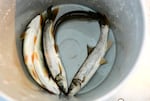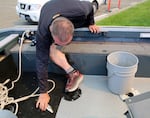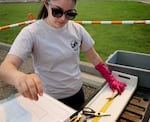
Northern Pikeminnow, brought in to the Columbia Point boat ramp in Richland, Washington, April 28, 2021. Pikeminnow eat juvenile salmon and steelhead before they make it to the ocean.
Kristian Foden-Vencil / OPB
At the Columbia Point boat ramp in Richland, Washington, retired firefighter Fred Ness brings a half dozen pikeminnow to the Northern Pikeminnow Sport-Reward Program to get them measured and counted.
“I had a good friend that was doing it, and I thought ‘Well, I’ll try it,’” he said. “One thing led to another, and here I am: I’m addicted to it now.”
To the untrained eye, a pikeminnow looks a lot like a small salmon. It can live for a decade or more and reach a couple of feet in length. It’s also native to the Pacific Northwest.

Retired firefighter Fred Ness collects the day’s pikeminnow catch at the Columbia Point boat ramp in Richland, Washington, April 28, 2021.
Kristian Foden-Vencil / OPB
But the most important thing to know about pikeminnow, at least for the purpose of Ness’ fishing habit and this story, is their diet: They eat baby salmon and steelhead. Lots of them. That makes them enemy number one for the Bonneville Power Administration, which spends millions of dollars trying to help young salmon reach the sea.
The BPA has decided pikeminnow pose a big threat, enough to justify putting a bounty on their slimy little heads. This year, a handful of new temporary stations are being added to encourage more people to take part.
“I’m getting better all the time,” Ness said. “But believe me, there’s a trick to it. There are people who out-fish me when I’m fishing two feet from them. They have it, and I don’t.”
The folks who make $20,000, $50,000 or even $100,000 a season use extra sensitive — extra expensive — fishing tackle. They even develop their own secret bait recipes featuring fish guts, salmon eggs and other messy stuff.
Ness has tried cheese balls, chicken liver and Mormon crickets, but admits he lacks the finesse to feel a pikeminnow as it picks at his bait. He finds it difficult to know when to quickly pull the line and set the hook.
“They’re hard to catch,” he said. “They just nibble, a very tender and delicate bite on the small ones.”

Last year Ness caught about 220 pikeminnow and made about $1,300. His boat cost $20,000 so he doesn't expect his investment to pay-off anytime soon.
Kristian Foden-Vencil / OPB
Anglers who are serious about making money on the pikeminnow program tend not to share their secret recipes or favorite fishing holes.
“Believe me,” said Ness, “there are some serious fishermen that would probably, if you anchored next to them, pull up and go somewhere else until you left and then they’d come back and re-anchor.”
He said anglers are good friends for the most part. But that edge of competition is never far away.
At 67, Ness doesn’t have a significant other, so he’s on the water at 5 a.m. almost every day, and will be for the next five months of the season.
Last year he made $1,300. His boat cost him $20,000, so he doesn’t expect to make back his investment any time soon.
“There’s people that I know that will stay out 24 hours,” he said. “They’ll come in. Check-in their fish. They’ll regroup and then go back out.”
Anglers have to come in after 24 hours because the program is strict about counting only fresh fish. For the last three years, that’s been the job of Washington Department of Fish and Wildlife scientific technician Brittney Salter. She runs the station near the Columbia Point boat ramp, measuring and counting pikeminnow.
“Sometimes they come in, and they’re still alive, like these ones here, flopping around,” she said. “And another identifier that I’ve learned is if they’ve been frozen for any period of time, they’ll just not look fresh, and they’ll also have a blue sheen to them sometimes.”
She’s on the lookout for pikeminnow that have been caught and frozen. They’ve usually come from streams and lakes far away from the main stem of the Columbia and Snake rivers.
“After each fish I also have to clip the tail fin, just to make sure nobody sneaks by, maybe grabs the fish out of the cooler when I’m not here,” she said. “Then every fish is going to go through the scanner to scan for PIT tags.”

Brittney Salter, scientist with the Washington Department of Fish and Wildlife, measures and checks pikeminnow coming in from anglers at the Columbia Point boat ramp in Richland, Washington.
Kristian Foden-Vencil / OPB
A PIT tag, or Passive Integrated Transponder tag, is a chip that scientists have put into a fish, to collect information. Anglers who catch a fish with one can make $100 or $500, depending on the tag. But anglers are mainly paid per fish: $5 each if they catch less than 25, and $8 each if they catch more than 200. The system favors volume — so 10% of those fishing end up with 80% of the money.
“I’ve actually had anglers that will come and park at the end of the parking lot and wait for every other angler to turn in their fish before they arrive, because they don’t want anyone following them,” Salter said. “They don’t want them to know where they were fishing. They don’t want anybody to listen to their conversation or see how many fish they’re turning in either.”
Anglers also have to tell Salter where they’ve been fishing, and all that information is sent to biologists who check on the pikeminnow population — a good year will see about 19 percent caught. The information is then conglomerated and made available at www.pikeminnow.org. The most anyone has ever made in a season is $119,000.
“A lot of folks in the early years would go out, they’d want to make their millions and they’d find out it’s not that easy,” said Eric Winther, the head of the Washington Department of Fish and Wildlife pikeminnow program.
“But they’d find out they could go out to lake ‘so-and-so’ and catch a bunch of them. And so that’s really where ... fraud kind of came in.”

Eric Winther heads the pikeminnow program with the Washington Department of Fish and Wildlife. He says a lot of people thought they could make a lot of money fishing pikeminnow but it isn't that easy to do.
Kristian Foden-Vencil / OPB
Authorities may also get suspicious if a newcomer turns up with a lot of fish. An angler could even be “green slipped,” meaning a biologist would interview them and maybe go and see where they’re fishing.
Winther said fraud isn’t such a problem now as regulators have set up several checks and protocols to verify an angler’s catch.
But the whole idea of encouraging anglers to catch one native species over another strikes Jeremy FiveCrows, of the Columbia River Inter-Tribal Fish Commission, as odd.
“It’s just kind of curious that the one that they have this reward system on is for the native fish, and really not the small mouth bass, the walleye and largemouth bass … that are also in the system that are non-native,” he said.
Winther said there’s already a whole sports fishery network set up to catch bass and walleye, so they don’t need to pay anglers to catch them. Pikeminnow, in contrast, are bony and hard to eat.
“There’s no real demand, no market for it,” he said. “So outside of paying people for it, there’s no way to really catch and exploit those fish. They are the main fish predator of baby salmon and steelhead. Studies show they take about 78% of all the smolts that are eaten by fish are taken by pikeminnow.”
Back on the river, retired iron worker Ted Rydstrom fishes two or three days a week for bass and walleye — not pikeminnow. “I really don’t know how, or taken an interest in how they fish for them,” he said. “I’ve caught them before, when I’ve been trolling for walleye …just not that much fun.”
He said they don’t put up much of a fight.

Ted Rydstrom ishes two or three days a week, but not for pikeminnow. “They don't put up much of a fight," he said.
Kristian Foden-Vencil / OPB
Anyone who wants to spend their summer on the water, making money and saving salmon, can sign up for the pikeminnow program.
Just know the preferred bait for some this year are Mormon crickets. They can be bought in tins. But for fresh, take a few friends to a shrubby steppe area, form a large circle and herd the crickets into the middle. They can be caught by hand or with a butterfly net.
But expert anglers say you should wear gloves. Unlike the easy-to-catch pikeminnow, this bait can bite and draw blood.
